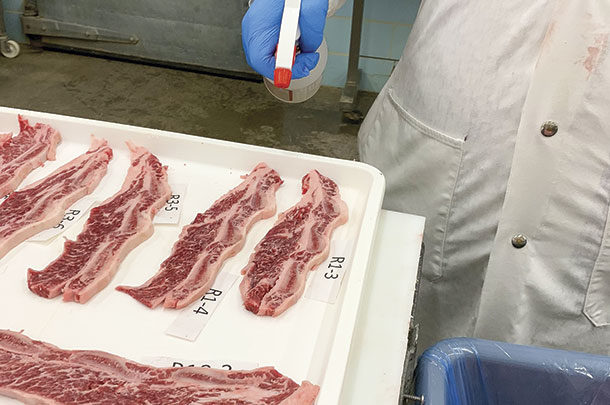Consumer demand, both domestically and abroad, drives beef prices and is one factor in determining profits or losses for cattle producers. In 2021, 15% of U.S. beef was exported, totaling over $10.5 billion and contributing $407.22 per head to the cattle industry.
While South Korea is not the largest buyer of U.S. beef, it is the largest growing market with the most potential to increase sales. In the last decade, exports to Korea have doubled in volume and tripled in value, showing an increased value per pound. As household incomes have grown, demand for beef and trade values have also risen. Because the level of beef production in Korea cannot meet consumer demand, supply must be supplemented with imports.
Consumers prefer beef from the U.S., as it has a higher degree of marbling and maintains a competitive price due to lowered tariffs compared to other beef-producing countries. Cuts such as the chuck roll and bone-in short ribs are commonly exported to Korea.
Shipping beef from America to South Korea across the Pacific Ocean takes at least 28 days, which doubles the aging time of chilled beef as compared to domestic product. While longer aging times can improve tenderness, it also can cause steaks to discolor at a faster rate, resulting in a shorter shelf life at the retail case. Thus, Korean retailers often only have a one-day shelf life for steaks from chuck rolls and bone-in short ribs due to the discoloration.
Because consumers rely on color to determine meat freshness, dark-colored steaks or steaks with browning are discounted or discarded as food waste. Ultimately, Korean retailers purchase a limited amount of U.S. beef to ensure all steaks are sold out in one day, but this results in an inability to restock when sold out. For example, if retailers sell all their steaks by 3 p.m., they cannot restock for the dinner rush, which is a loss of potential sales and, therefore, a loss of income for U.S. cattle producers.
The shipping time to Korea from Australia, our major competitor for beef, is considerably shorter, resulting in a longer retail shelf life that is more desirable to retailers. Additionally, Australia relies heavily on forage-based diets, which increases vitamin E levels in the meat. Vitamin E is an antioxidant that extends steak shelf life. When researchers sought a way to delay U.S. beef discoloration, switching U.S. feeding practices from grain-based diets to forage-based diets was not a feasible option. However, previous research conducted by Dr. Michael Colle of the University of Idaho suggested that spraying antioxidants on the surface of the steak may be a solution.
How it works
While using antioxidants on beef steaks is not a common practice, the meat industry regularly mixes antioxidants into ground products, such as pork and turkey. Naturally occurring antioxidants like rosemary extract and acerola cherry powder are largely flavorless, especially compared to beef’s robust flavor, and they also delay oxidation.
Oxidation of color pigments results in discoloration, while at the same time, oxidized lipids produce off-flavors. When these antioxidants are used together, they will regenerate each other to continue working against discoloration and off-flavors.
At the suggestion of Dr. Travis Arp at the U.S. Meat Export Federation, along with funding from the Idaho Beef Council via the beef checkoff, research was conducted at the University of Idaho by Colle, Jessie Van Buren and the meat science laboratory to evaluate the effectiveness of spraying rosemary extract and acerola cherry powder on the surface of thinly cut steaks from chuck rolls and bone-in short ribs that were aged for 28 days to simulate shipping time. Steaks from the chuck rolls and short ribs were cut in the Korean style of less than 0.5-inch thick. The steaks were displayed in a manner that would mimic meat at a grocery store – on shelves with bright lights at refrigerated temperatures. Over the course of four days, color and lipid oxidation were measured.

 Notice the discoloration in the untreated chuck roll (top) versus the treated chuck roll (bottom). Photos provided by Jessie Van Buren.
Notice the discoloration in the untreated chuck roll (top) versus the treated chuck roll (bottom). Photos provided by Jessie Van Buren.
In chuck roll steaks, a combination of the antioxidants improved redness and delayed oxidation, thereby preventing off-flavors. Bone-in short rib steaks treated with antioxidants were a brighter cherry-red color, had redder bone marrow and delayed off-flavors. Unexpectedly, antioxidants also decreased fluid lost during retail display. Steak fluid loss, or “purge,” can be unsightly for customers, which may lead to decreased salability.
The findings of this research allows the U.S. Meat Export Federation to recommend that Korean retailers apply an antioxidant solution that contains 0.05% acerola cherry powder and 0.2% rosemary extract. From a financial standpoint, these antioxidants are so cost-effective that Korean retailers could spray nearly 3,000 steaks for a single dollar. This very simple and inexpensive suggestion improves the color shelf life of U.S. beef by two days. As a result, Korean retailers could be more willing to display more beef and thereby purchase larger amounts of U.S. beef per day and increase international demand, which would ultimately lead to improved profits for the U.S. beef industry and cattle producers.
In the future, the University of Idaho Meat Science Laboratory will research applying antioxidants to frozen beef with intentions to research other discolored cuts, such as top round and tenderloin, as well as to evaluate the ability of antioxidants to reduce purge during aging (shipping) and retail display. The researchers gratefully acknowledge financial support for this project from beef checkoff dollars provided by the Idaho Beef Council.











